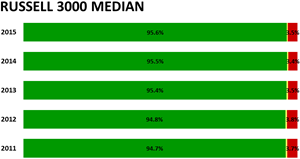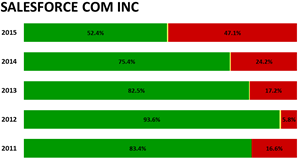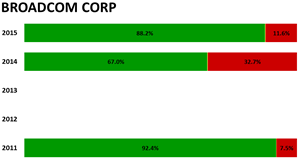|

Business Day
Tech Companies Fly High on Fantasy Accounting
JUNE 21, 2015
Technology shares have been powering the stock market recently,
outperforming the broader stock indexes by wide margins. The
tech-heavy Nasdaq 100, for example, is up 19 percent over the last 12
months, almost twice as much as the Standard & Poor’s 500-stock index,
which has risen 10 percent.
Investor enthusiasm for all things tech is understandable, given the
disruptions the industry is bringing to so many businesses and the
potential profits associated with that upheaval.
But
there’s a more troubling aspect of the current exuberance for
technology stocks: the degree to which so many of the popular
companies with premium-priced shares promote financial results and
measures that exclude their actual costs of doing business.
These
companies, in effect, highlight performance that is based more on
fantasy than on reality.
Corporations still must report their financial results under generally
accepted accounting principles, or GAAP. But they often play down
those figures, advising investors to focus instead on the numbers
favored by those in the executive suite — who, it just so happens,
stand to gain personally from the finagling.
| |
Fair Game
A
column from Gretchen Morgenson examining the world of finance
and its impact on investors, workers and families
See More »
|
Among
the biggest costs these companies ask investors to ignore are those
associated with stock-based compensation, acquisitions and
restructuring. But these are genuine expenses, so excluding them from
financial reporting makes these companies’ performance look better
than it actually is.
This,
in turn, makes it harder for investors to understand how their
businesses are really doing and whether their shares are overvalued or
fairly priced.
Not
all technology companies encourage the use of funny figures. Apple and
Netflix report only GAAP results. But they are in the minority.
Cooking up funny figures to accentuate the positive at a company is
not a new problem. Justifying rocketing stock prices with kooky
financial metrics was central to the 1999 Internet mania. We all
remember how that ended.
But
while today’s creativity in financial reporting is more down to earth
than it was during the last boom, the use of performance measures that
exclude some basic corporate costs seems to be growing among
companies.
Jack
Ciesielski, publisher of
The Analyst’s Accounting Observer,
studied this issue last fall. For the five years that ended in 2013,
he found that the number of cost items excluded from the reports of
104 large technology, health care and telecommunications companies had
risen to 504 in 2013, up from 365 in 2009.
We’re
talking real money. In 2013, Mr. Ciesielski also found that the
difference between these companies’ GAAP profits and earnings without
the bad stuff was $46 billion in 2013. This was down from 2012, but it
was more than double the amount in 2009.
But
perhaps the most disturbing aspect of the funny numbers used by
companies is the way they serve to raise
executive pay levels. That’s
because these companies often exclude the cost of stock grants awarded
to executives and employees, significantly improving reported
performance.
Consider
Salesforce.com, a
supplier of customer management software and services. In spite of
recording a loss from operations of $146 million in fiscal 2015, the
company’s stock is a highflier; its market capitalization is almost
$50 billion.
Investors may be focusing on the revenue growth at
Salesforce.com — up 32 percent
last year and up 34 percent on average in each of the last four years.
Or that the company’s most recent loss was half that generated in
2014.
But
when Salesforce.com computes its executives’ cash incentive pay, its
$146 million operating loss turns into a $574 million operating
profit. This transformation occurs because the company excluded $565
million worth of stock grants awarded to employees last year.
Investors may be growing concerned about these games of pretend. A
sign of the discontent is the increasing support for “say on pay”
measures, in which shareholders express views on company pay
practices.
For
example, at Salesforce.com’s annual meeting this month, 47 percent of
the shares voted
were against the company’s pay
plan. That’s almost twice the 24 percent dissent the company received
from shareholder votes at the 2014 meeting.
Chi
Hea Cho, a spokeswoman for Salesforce.com, said in a statement: “We
describe our pay practices in significant detail in our proxy
statement, including our compensation philosophy and the rationale for
our executive compensation decisions. We value the opinions of our
shareholders and have engaged in an active dialogue with them on
executive compensation practices.”
Ms.
Cho declined to comment on the company’s decision to exclude stock
grants from its performance pay measures. But she pointed me to
company filings, which note that “stock-based expense varies for
reasons that are generally unrelated to operational decisions and
performance in any particular period.”
Brian
Foley, an independent compensation consultant in White Plains,
questioned any company’s exclusion of stock grants when assessing
executive performance.
“One
has to be very disciplined about how you measure performance,” he said
in an interview. “These companies are paying out real value in option
and stock awards every year, and if those awards are such a key
component and driver of overall compensation in such companies, why
isn’t the cost of that key component part of the mix when it comes to
judging annual performance and sizing senior management annual
bonuses?”
Some companies are changing their practices
after hearing from investors. This year,
Broadcom, a
supplier of integrated circuits, said it would no longer exclude stock
awards from its performance pay measures.
Companies can’t play pretend about the true cost of stock grants in
their regulatory filings, of course. And vigilant shareholders know
that these expenses often become glaringly evident through the prism
of billion-dollar share buybacks conducted by these companies. Many
technology companies have to pursue these repurchase programs to limit
the diluting effect of their generous stock grants. And they pay
handsomely to do so.
Ken
Broad is founding partner and portfolio manager at
Jackson Square Partners, a money
management firm in San Francisco that oversees $30 billion in assets.
He said that it was up to investors to stop accepting performance
figures and analysts’ estimates that exclude real costs.
“Lots
of investors have ever-shorter time horizons and they care less about
what’s embedded in the number than whether the company beat the
consensus estimate,” he said in an interview on Thursday.
Part
of it, too, is bull-market thinking. And when the music stops?
“This
stuff doesn’t matter,” he said, “until it does.”
A version of this article appears in print on June 21, 2015, on page
BU1 of the New York edition with the headline: Flying High on Fantasy
Accounting.
© 2015 The
New York Times Company |


